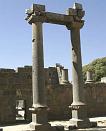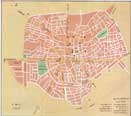 |
| in Syria |
|
Español | عربي |
Introduction As Suwayda , Suwaida or Sweida is Located 128 Km southeast of Damascus in southwestern Syria, at the eastern margin of the Hawran (or Houran) region in the foothills of Al-Duruz Mountains, close to the border with Jordan. Al-Suwayda' is now a local agricultural market centre. It has ruins of a 3rd-century Roman temple and a 5th-century It is the capital of Muhafazat as Suwayda, one of Syria's 14 governorates, bordering Jordan in the South and the governorates of Daraa in the West and Rif Dimashq in the North and East. The inhabitants of the town are mainly Druze with a prominent Greek orthodox minority; it is also the seat of a Greek Orthodox bishop. The population of the town was estimated in 2002 to be 87,000 History The town was founded by the Nabataeans as Suada in the 1st century BC, afterwards it was called Dionysias during Hellenistic and Roman times, for Dionysus the god of wine - the town is situated in a famous ancient wine-producing region. Main attractions and historical sites As Suwayda has some archeological excavations of the ancient Nabataean, Hellenistic, Roman and Byzantine times, most notably the town’s Hellenistic agora, and the remnants of a big Byzantine church from the 6th century most probably the Church of Saint Sergius. the town has also many Roman time old houses that are still inhabited by locals, a conical pond, and a Roman amphitheatre still to be uncovered Suweida museum has quite a large collection of interesting mosaics that resemble the ones found in the Shahba museum. Themes include Artemis taking a bath, and a banquet scene. There is also a fine collection of statues sculpted in the black basalt, although not as elegant as marble statues they deserve just as much credit. Shahba (Philippopolis) , a town at As Suwayda Governorate, was tthe birthplace of the Syrian Emperor Philip, who ruled the Roman Empire between 244 and 249 A.D., he dedicated himself to building the city up to a metropolis. The city was renamed Philippopolis in dedication to the emperor. The emperor is said to have wanted to turn the city into a replica of Rome itself. Temples, triumphal arches, baths, a theatre, and a great wall surrounding the city were all built based on the plan of a typical Roman city. The building of the city stopped abruptly after the death of Philip. Shahba today contains well-preserved ruins of the ancient Roman city. A museum located in the city exhibits some beautiful examples of Roman mosaic art. Salkhad a Syrian city in the As Suwayda governorate. It has a population of 15,000 inhabitants and it is located at 1350 metres above sea level in the central Jabal el Druze highlands. Mentioned several times in the Bible as "Salcah", as a settlement in biblical Bashan. During the second century BC Salcah was a flourishing Nabataean city, where the gods Dushara and Allat were worshiped. Afterwards it was incorporated into the Roman province of Arabia, it was one of the important citys in Hauran during Roman and later Byzantine epochs, Salkhad is indicated in the Madaba mosaic map of the sixth century AD. Due to the strategic position of the city overlooking Hauran plains to the west, the Ayyubid dynasty built a fortress in Salkhad between 1214 - 1247 to counter a possible attack of the Crusades into inner Hauran. The importance of the city decreased after the Crusades, and it was occasionally overrun by Bedouins seeking pasture in the summer for their flocks. A number of Greek orthodox Christians, of Ghassanid ancestry, successively remained in the region. Salkhad and the adjacent region were re-inhabited by Druze families from Mount Lebanon in the late 17th , 18th ,and 19th centuries. During Ottoman times the city enjoyed a feudal-type autonomy like much of the Jabal el Druze area under the chieftaincy of Al-Hamdan family and later Al-Atrash family, many battles against Ottoman Turks took place in this region by the locals to maintain their autonomy. In the early 20th century the city was part of the 1921-1936 Druze state under the French Mandate of Syria, the state was gradually incorporated into Syria after the Syrian Revolution of 1925-1927 led by Sultan Al-Atrash. The fortress of Salkhad is the most important monument located in a hill inside the city , built between 1214-1247 by the Ayyubid dynasty as a part of their defences against the crusades. It is said that this fortress were built in the site of older Roman fortifications. A hexagonal basalt minaret still standing intact in the city’s main square. Many Roman old time houses, still partially inhabited by locals. Nabatean, Roman and Ayyubid Tombs with decorative motifs. Qanawat was a city of great importance during the Roman period. In the year 60 B.C., the Romans named it one of the Decapolis league of commercial cities of which Damascus was the chief city. Its importance explains the richness of its ruins, which are among the most interesting in the whole Jabal Al-Arab region. Here can be found two palaces built by the Romans in approximately the second century. These basilica shaped buildings grouped around an atrium were adopted in the fourth through the fifth centuries by Christians. The ruined tower at the corner of one of the buildings is most probably the remains of a late addition to the Christian church. The tower is typical of the embellishments added to the Churches in northern Syria. The Christians having used much of the original classical stoneware, the buildings are beautifully decorated. Today in Qanawat the visitor can also see the remains of a Roman mausoleum, a small theater with nine rows of seats, a water fountain and a temple of Helios; a lesser version of the temples at Palmyra and Baalbeck. On the side there is also another temple from the second century dedicated to Zeus |
|||||||||||||||||||||||||||||||||||||||||||||||||||||
|
|
||||||||||||||||||||||||||||||||||||||||||||||||||||
|
|
|
|

Custom Search
|
| © Copyright Homsonline.com |
| |
||
| |
|
|




